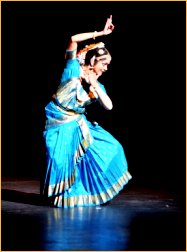 |
 |
The Naatya Ensemble: Traditional,
Educational, and Enjoyable
It takes a special talent to present an advanced art form to an audience that has different levels of expertise, but Shoba Sharma, the founder and artistic director of the Naatya dance ensemble, has found a way. The Naatya ensemble (www.naatya.org) performs Bharatha Natyam, an Indian classical dance that traces its roots to the Natya Sastra, a text on Hindu dance from over two millennia ago. |
 |
| The
ensemble recently completed engagements in two prominent venues in Center
City, Philadelphia: the Dance Boom 2003 festival at the Wilma Theater and
more recently the Udavum Karangal benefit at the Kimmel Center. In
each case, the audience contained individuals familiar with classical dance
and its ancient Hindu origins; Westerners who are for the most part less
familiar; and younger Indians or US-born Americans of Asian Indian ancestry
whose cultural links to this rich tradition may not be as strong as they
could be.
Because each
dance tells a story, the key to a diverse audience is a short, crisp explanation
from Sharma before each dance. Importantly, during her explanation, she
demonstrates dance steps that convey events in the narrative.
The audience was absolutely captivated, including my 11-year-old daughter, who sat next to me. The costumes were intricate and traditional. The dancers performed graceful, complex routines, involving precise body, hand, and eye movements. But it was all quite easy to follow. These are wonderful stories, and they come alive with the dance. The performance by Shoba Sharma and the Naatya ensemble at the Kimmel Center was for the benefit of Udavum Karangal, a network of orphanages founded by S Vidyakar, who was himself an orphan. Other items on the program included a fashion presentation by Anand Jon, brief remarks by the writer and director M Night Shyamalan, and then presentations of citations from Mayor Street and Governor Rendell to Vidyakar, who came from India for this event. It was a remarkable spectacle. Dr. Kevin Williams is a graduate of Harvard University and the Johns Hospital Medical School. He is presently Professor of Medicine at Jefferson University Hospital in Philadelphia, PA. Dr. Williams is an avid follower of classical Western music and Indian classical dance. |